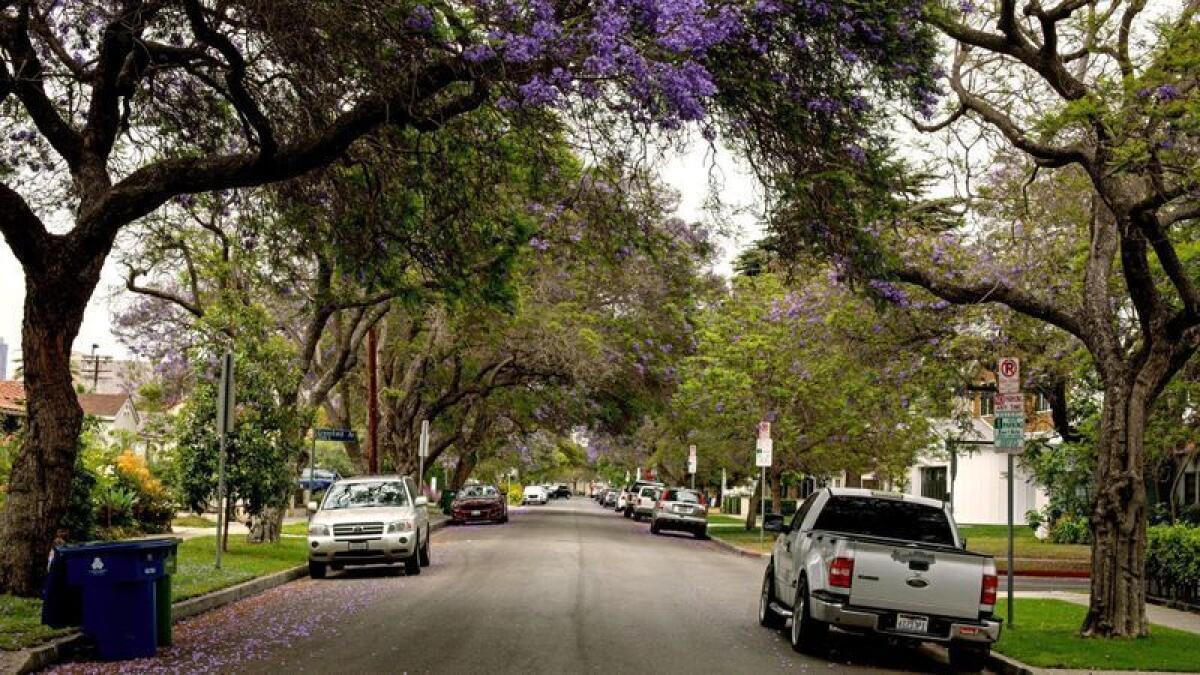Editorial: L.A.’s trees are more essential than ever. The city needs to start treating them that way

While bird lovers, environmentalists and poets have long put a high value on trees, the hard-nosed number crunchers in government have not. Trees have often been treated as merely aesthetic enhancements. Nice, but not essential. That’s one reason why tree maintenance is among the first government services cut during a recession.
That limited view is changing, and there is increasing recognition that trees are more than just pretty things. With climate change, big trees will be increasingly useful to remove pollution from the air, collect water during rainstorms and create shade that cools nearby property.
But for all the benefits that trees provide Los Angeles, city officials still do not hold the urban forest in the same regard as other public infrastructure, like streets and storm drains. That’s one of the key findings from a recent report commissioned by City Plants, a nonprofit that works with city departments to plant and care for public trees.
Climate change is expected to make Los Angeles a hotter, drier city, and having more big, healthy trees could lessen the impact.
While outside experts have appraised the value of Los Angeles’ trees (including privately owned ones) at $12 billion, city officials have never attached such an economic value to the local urban forest. The city doesn’t quantify the value of the trees themselves, nor the energy and water savings generated by mature specimens. As a result, the city hasn’t made it a priority to invest and maintain trees as public assets.
There are multiple reasons why trees get short shrift. Jurisdiction over the city’s urban forest crosses multiple agencies — from the Recreation and Parks Department to the Bureau of Street Services to the Department of Water and Power (which trims trees next to power lines). There hasn’t been a singular focus on tree care.
The City Plants report, which was prepared by environmental consulting firm Dudek, says Los Angeles should be spending three times as much on its urban forest. The city spends about $25 million now, but the budget would have to be closer to $80 million to match comparable cities with robust urban forests, such as New York City and Melbourne, Australia.
The reality is that there are always far more infrastructure needs than there are dollars. Still, it’s clear that Los Angeles needs to invest more in its urban forest. It’s especially important now because trees are both more essential than ever and more at risk.
Climate change is expected to make Los Angeles a hotter, drier city, and having more big, healthy trees could lessen the impact. A mature urban forest and dense tree canopy can provide relief on the hottest days — shaded surfaces can be 20 to 45 degrees cooler than those in direct sun — and reduce air conditioning demand, which helps ease the strain on the city’s electrical grid.
Tree roots also capture and store rainwater, which helps the city make better use of its water supply at a time of more extreme weather conditions and wider swings between periods of drought and flooding.
But many mature trees in the city have been weakened by drought, a problem exacerbated when water-conscious residents stopped irrigating their plants. Invasive pests are a major threat too, spreading disease that could infest an estimated 38% of the 71 million trees across the Southern California region and cause a massive die-off.
Enter the Fray: First takes on the news of the minute from L.A. Times Opinion »
Then there’s the damage caused by the city itself. Los Angeles has committed to spending $1.4 billion over the next 30 years to fix the city’s busted sidewalks, many of which were damaged by tree roots. While the sidewalk repairs are essential, the process often fells mature trees.
In response to the City Plants report, the Board of Public Works has called for a “Tree Summit” to gather advocates and experts to recommend policies to protect the urban forest. The city’s Recreation and Parks Department is compiling an inventory of trees in the city parks, which is vital to tracking the loss of trees to disease and drought and to ensure adequate replacement. The city needs to come up with $3 million more to complete an inventory of trees planted along the streets.
The Bureau of Street Services has begun discussions on how to quantify the costs and value of trees, which will help inform stronger policies to protect mature trees and encourage the planting of new ones. Yes, trees are lovely. But to survive and flourish, Los Angeles needs to treat its urban forest like a true piece of public infrastructure.
Follow the Opinion section on Twitter @latimesopinion and Facebook
More to Read
A cure for the common opinion
Get thought-provoking perspectives with our weekly newsletter.
You may occasionally receive promotional content from the Los Angeles Times.










